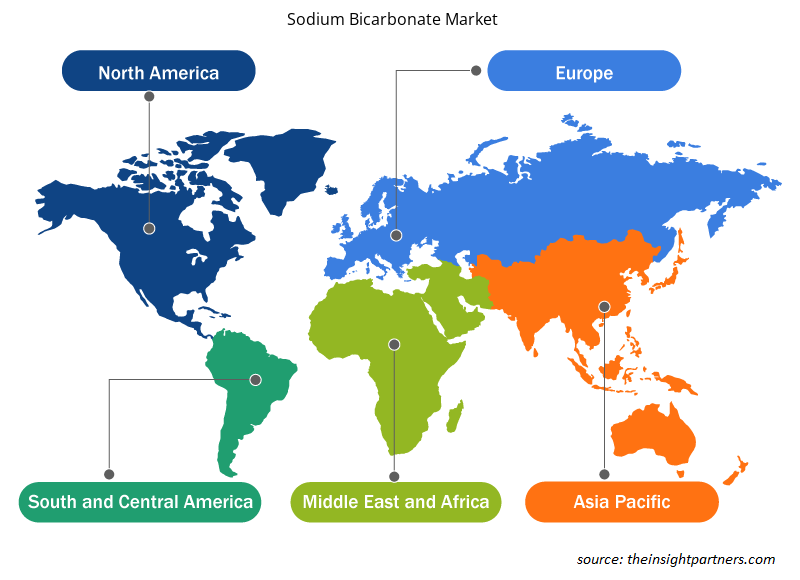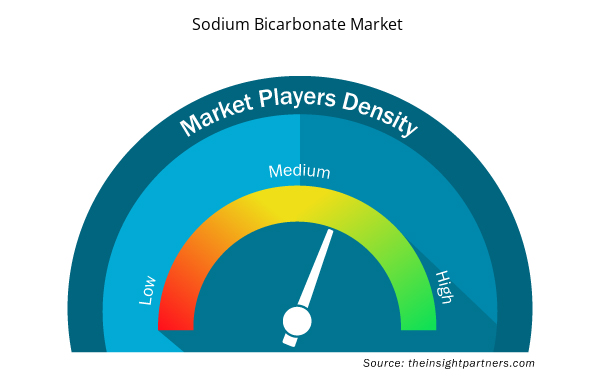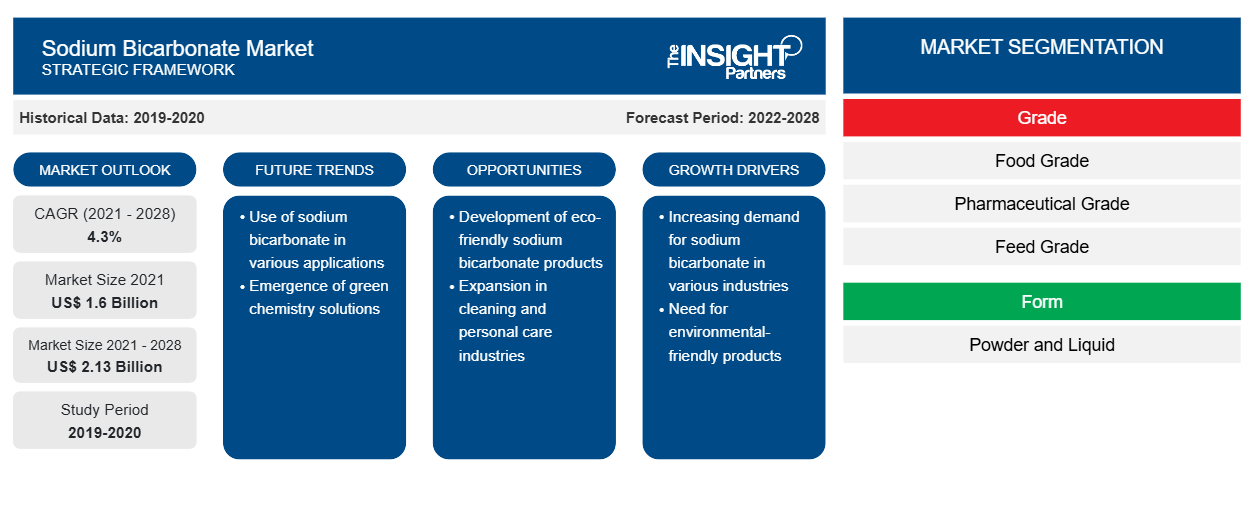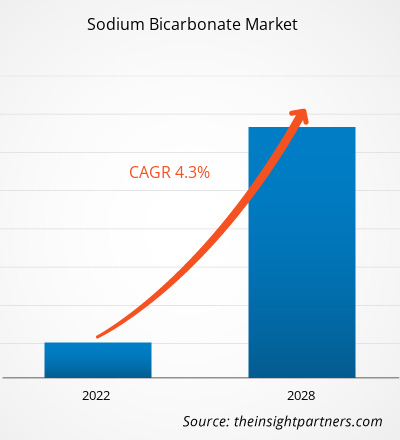[研究报告] 碳酸氢钠市场预计将从 2021 年的 15.9637 亿美元增长到 2028 年的 21.3333 亿美元;预计 2021 年至 2028 年的复合年增长率为 4.3%。
碳酸氢钠通常被称为小苏打或碳酸氢钠。它是一种化学化合物,分子式为 NaHCO₃。碳酸氢钠用途广泛。它广泛用于食品和饮料、化学、制药、农业以及化妆品和个人护理行业。
2021 年,亚太地区占据了全球碳酸氢钠市场的最大收入份额。碳酸氢钠在动物饲料、烘焙食品、清洁产品和化妆品等各种应用中的使用越来越多,这主要推动了亚太地区市场的增长。可支配收入的增加与消费者对不同烘焙产品的需求增加有关。此外,社会经济水平的提高和数字与制造业的大规模发展导致印度等国家对化妆品的需求旺盛。该地区的化妆品行业增长较快,许多人购买个人护理和美容产品。因此,碳酸氢钠的需求正在增加,因为它用于化妆品和个人护理行业的牙膏、除臭剂、面膜、洁面泡沫和凝胶以及化妆粉中。
定制此报告以满足您的需求
您可以免费定制任何报告,包括本报告的部分内容、国家级分析、Excel 数据包,以及为初创企业和大学提供优惠和折扣
- 获取此报告的关键市场趋势。这个免费样品将包括数据分析,从市场趋势到估计和预测。
COVID-19 疫情对碳酸氢钠市场的影响
由于封锁、旅行禁令和企业停业,COVID-19 疫情影响了各国的经济和行业。2020 年,由于国家和国际边界的限制导致价值链中断,各行各业不得不放慢运营速度。疫情扰乱了制造流程,并因政府当局实施的限制而导致原材料供应链中断。COVID-19 疫情迫使人们呆在家里。人们转而利用闲暇时间提高烹饪技能。许多人开始沉迷于烘焙和烹饪活动。这导致了对各种烘焙原料的需求,包括碳酸氢钠。
各行各业也在克服原材料供应链中断带来的挑战。因此,各行各业对碳酸氢钠的需求都在增加。
市场洞察
烘焙食品消费量上升
碳酸氢钠是烘焙中最常用的成分之一。它可以用作烘焙行业的发酵剂、pH 缓冲剂和泡腾剂。面包、饼干、蛋糕、馅饼和糕点是全球烘焙行业最常见的产品。面包是许多欧洲国家的主食。有机面包也越来越受欢迎。就有机面包而言,德国正在成为欧洲最大的市场之一。由于德国的气候条件,德国的面包种类繁多。这里的气候适合种植各种谷物。美国的烘焙业已经很成熟。此外,由于消费者对健康食品的需求日益增加,他们继续购买各种高品质、新鲜出炉的食品,澳大利亚的烘焙食品行业也在增长。因此,烘焙食品消费量的激增正在推动全球碳酸氢钠市场的发展。
成绩洞察
根据等级,全球碳酸氢钠市场分为食品级、医药级、饲料级、技术级和其他。2021 年,技术级和其他部分在全球碳酸氢钠市场中占有最大份额。技术级碳酸氢钠通常用于商业和工业用途。它用于不同的应用,包括化学合成、染料、皮革、灭火器、水和废水处理、塑料成型、陶瓷、纺织、废气脱硫和造纸。
最终用户洞察
根据最终用户,全球碳酸氢钠市场细分为食品和饮料、制药、农业、化学、化妆品和个人护理、纺织和皮革、家庭护理等。2021 年,食品和饮料部门在全球碳酸氢钠市场中占有最大份额。碳酸氢钠是食品和饮料行业必不可少的成分。它是饮料中一种有价值的缓冲剂和中和剂。在几种软饮料中,碳酸氢钠被用作二氧化碳的来源。
Solvay SA;Tosoh Corporation;Burwell Technologies;All Chemical Manufacturing & Consultancy Pty Ltd;Pon Pure Chemicals Group;Church & Dwight, Inc.;Sişecam;AGC Inc.;Ciech SA;和 GHCL Limited 是全球碳酸氢钠市场的主要参与者。市场参与者专注于提供高质量的产品以满足客户需求。
报告亮点
- 碳酸氢钠市场的渐进式行业趋势可帮助参与者制定有效的长期战略
- 发达市场和发展中市场采用的业务增长战略
- 2020 年至 2028 年碳酸氢钠市场定量分析
- 全球碳酸氢钠需求量估计
- 波特五力分析说明了行业内买家和供应商的效力
- 了解竞争市场状况的最新发展
- 市场趋势和前景,以及推动和抑制碳酸氢钠市场增长的因素
- 通过强调支撑商业利益的市场策略来协助决策过程,从而促进市场增长
- 碳酸氢钠市场各节点规模
- 市场的详细概述和细分,以及碳酸氢钠行业动态
- 各地区碳酸氢钠市场规模及增长潜力
碳酸氢钠市场区域洞察
Insight Partners 的分析师已详细解释了预测期内影响碳酸氢钠市场的区域趋势和因素。本节还讨论了北美、欧洲、亚太地区、中东和非洲以及南美和中美洲的碳酸氢钠市场细分和地理位置。

- 获取碳酸氢钠市场的区域具体数据
碳酸氢钠市场报告范围
| 报告属性 | 细节 |
|---|---|
| 2021 年市场规模 | 16亿美元 |
| 2028 年市场规模 | 21.3亿美元 |
| 全球复合年增长率(2021 - 2028) | 4.3% |
| 史料 | 2019-2020 |
| 预测期 | 2022-2028 |
| 涵盖的领域 | 按年级
|
| 覆盖地区和国家 | 北美
|
| 市场领导者和主要公司简介 |
|
市场参与者密度:了解其对商业动态的影响
碳酸氢钠市场正在快速增长,这得益于终端用户需求的不断增长,而这些需求又源于消费者偏好的不断变化、技术进步以及对产品优势的认识不断提高等因素。随着需求的增加,企业正在扩大其产品范围,进行创新以满足消费者的需求,并利用新兴趋势,从而进一步推动市场增长。
市场参与者密度是指在特定市场或行业内运营的企业或公司的分布情况。它表明在给定市场空间中,相对于其规模或总市场价值,有多少竞争对手(市场参与者)存在。
在碳酸氢钠市场运营的主要公司有:
- 索尔维公司
- 东曹株式会社
- 丘奇与德怀特公司
- 硅橡胶
- AGC公司
免责声明:上面列出的公司没有按照任何特定顺序排列。

- 获取碳酸氢钠市场顶级关键参与者概览
全球碳酸氢钠市场(按等级)
- 食品级
- 医药级
- 饲料级
- 工业级及其他
全球碳酸氢钠市场,按形式
- 粉末
- 液体
全球碳酸氢钠市场,按最终用户划分
- 食品和饮料
- 制药
- 农业
- 化学
- 化妆品和个人护理
- 纺织和皮革
- 家庭护理
- 其他的
公司简介
- 索尔维公司
- 东曹株式会社
- 宝威尔科技
- 全化学制造与咨询有限公司
- Pon Pure Chemicals集团
- 丘奇与德怀特公司
- 西谢坎
- AGC公司
- 西赫公司
- GHCL有限公司
- 历史分析(2 年)、基准年、预测(7 年)及复合年增长率
- PEST 和 SWOT 分析
- 市场规模价值/数量 - 全球、区域、国家
- 行业和竞争格局
- Excel 数据集



Report Coverage
Revenue forecast, Company Analysis, Industry landscape, Growth factors, and Trends

Segment Covered
This text is related
to segments covered.

Regional Scope
North America, Europe, Asia Pacific, Middle East & Africa, South & Central America

Country Scope
This text is related
to country scope.
常见问题
The sodium bicarbonate market is expanding as a result of rising consumer demand for convenience foods. Its usage in baked products such as bread, biscuits, and cakes is driven by its capacity to neutralise acidic conditions and maintain a stable PH level in food. Additionally, sodium bicarbonate's low environmental impact and lower manufacturing costs are advantageous to baking soda manufacturers.
During the forecast period, the agriculture segment is expected to be the fastest-growing segment. Using sodium bicarbonate in agrochemicals is driven by treating insects in farmlands and washing pesticides from fruits & vegetables. Moreover, it is environment friendly natural agent therefore used in the form of pesticides in agricultural farm which is expected to accelerate sodium bicarbonate market demand during the forecast period.
In 2021, the powder held the largest market share. The powder form of sodium bicarbonate is widely used in baking products such as cakes, biscuits, and bread. It is also used as a cleansing agent due to its mild disinfectant properties. Moreover, animal feed and fire extinguishers' applications led to the powder segment's dominance in 2021.
In 2021, the technical grade and others segment held the largest market share. Increasing usage of technical grade sodium bicarbonate for applications such as chemical synthesis, dyes, leather, fire extinguishers, water treatment, and plastic moulding has led to the dominance of technical grade and others segment in the sodium bicarbonate market.
The major players operating in the sodium bicarbonate market are Solvay S.A., Tosoh Corporation, Church & Dwight, Inc., SiÅŸecam, AGC Inc., Ciech S.A., Tata Chemicals, Ciner Group, Bashkhim Group, and Novacap Group.
In 2021, Asia-Pacific accounted for the largest share of the global sodium bicarbonate market. Growing demand from different end-use industries, including food and beverages, animal feed, pharmaceuticals, and textiles, led to the dominance of the Asia Pacific region in 2021.
Trends and growth analysis reports related to Chemicals and Materials : READ MORE..
The List of Companies - Sodium Bicarbonate Market
- Solvay S.A.
- Tosoh Corporation
- Church & Dwight, Inc.
- Si?ecam
- AGC Inc.
- Ciech S.A.
- Tata Chemicals
- Ciner Group
- Bashkhim Group
- Novacap Group
The Insight Partners performs research in 4 major stages: Data Collection & Secondary Research, Primary Research, Data Analysis and Data Triangulation & Final Review.
- Data Collection and Secondary Research:
As a market research and consulting firm operating from a decade, we have published and advised several client across the globe. First step for any study will start with an assessment of currently available data and insights from existing reports. Further, historical and current market information is collected from Investor Presentations, Annual Reports, SEC Filings, etc., and other information related to company’s performance and market positioning are gathered from Paid Databases (Factiva, Hoovers, and Reuters) and various other publications available in public domain.
Several associations trade associates, technical forums, institutes, societies and organization are accessed to gain technical as well as market related insights through their publications such as research papers, blogs and press releases related to the studies are referred to get cues about the market. Further, white papers, journals, magazines, and other news articles published in last 3 years are scrutinized and analyzed to understand the current market trends.
- Primary Research:
The primarily interview analysis comprise of data obtained from industry participants interview and answers to survey questions gathered by in-house primary team.
For primary research, interviews are conducted with industry experts/CEOs/Marketing Managers/VPs/Subject Matter Experts from both demand and supply side to get a 360-degree view of the market. The primary team conducts several interviews based on the complexity of the markets to understand the various market trends and dynamics which makes research more credible and precise.
A typical research interview fulfils the following functions:
- Provides first-hand information on the market size, market trends, growth trends, competitive landscape, and outlook
- Validates and strengthens in-house secondary research findings
- Develops the analysis team’s expertise and market understanding
Primary research involves email interactions and telephone interviews for each market, category, segment, and sub-segment across geographies. The participants who typically take part in such a process include, but are not limited to:
- Industry participants: VPs, business development managers, market intelligence managers and national sales managers
- Outside experts: Valuation experts, research analysts and key opinion leaders specializing in the electronics and semiconductor industry.
Below is the breakup of our primary respondents by company, designation, and region:

Once we receive the confirmation from primary research sources or primary respondents, we finalize the base year market estimation and forecast the data as per the macroeconomic and microeconomic factors assessed during data collection.
- Data Analysis:
Once data is validated through both secondary as well as primary respondents, we finalize the market estimations by hypothesis formulation and factor analysis at regional and country level.
- Macro-Economic Factor Analysis:
We analyse macroeconomic indicators such the gross domestic product (GDP), increase in the demand for goods and services across industries, technological advancement, regional economic growth, governmental policies, the influence of COVID-19, PEST analysis, and other aspects. This analysis aids in setting benchmarks for various nations/regions and approximating market splits. Additionally, the general trend of the aforementioned components aid in determining the market's development possibilities.
- Country Level Data:
Various factors that are especially aligned to the country are taken into account to determine the market size for a certain area and country, including the presence of vendors, such as headquarters and offices, the country's GDP, demand patterns, and industry growth. To comprehend the market dynamics for the nation, a number of growth variables, inhibitors, application areas, and current market trends are researched. The aforementioned elements aid in determining the country's overall market's growth potential.
- Company Profile:
The “Table of Contents” is formulated by listing and analyzing more than 25 - 30 companies operating in the market ecosystem across geographies. However, we profile only 10 companies as a standard practice in our syndicate reports. These 10 companies comprise leading, emerging, and regional players. Nonetheless, our analysis is not restricted to the 10 listed companies, we also analyze other companies present in the market to develop a holistic view and understand the prevailing trends. The “Company Profiles” section in the report covers key facts, business description, products & services, financial information, SWOT analysis, and key developments. The financial information presented is extracted from the annual reports and official documents of the publicly listed companies. Upon collecting the information for the sections of respective companies, we verify them via various primary sources and then compile the data in respective company profiles. The company level information helps us in deriving the base number as well as in forecasting the market size.
- Developing Base Number:
Aggregation of sales statistics (2020-2022) and macro-economic factor, and other secondary and primary research insights are utilized to arrive at base number and related market shares for 2022. The data gaps are identified in this step and relevant market data is analyzed, collected from paid primary interviews or databases. On finalizing the base year market size, forecasts are developed on the basis of macro-economic, industry and market growth factors and company level analysis.
- Data Triangulation and Final Review:
The market findings and base year market size calculations are validated from supply as well as demand side. Demand side validations are based on macro-economic factor analysis and benchmarks for respective regions and countries. In case of supply side validations, revenues of major companies are estimated (in case not available) based on industry benchmark, approximate number of employees, product portfolio, and primary interviews revenues are gathered. Further revenue from target product/service segment is assessed to avoid overshooting of market statistics. In case of heavy deviations between supply and demand side values, all thes steps are repeated to achieve synchronization.
We follow an iterative model, wherein we share our research findings with Subject Matter Experts (SME’s) and Key Opinion Leaders (KOLs) until consensus view of the market is not formulated – this model negates any drastic deviation in the opinions of experts. Only validated and universally acceptable research findings are quoted in our reports.
We have important check points that we use to validate our research findings – which we call – data triangulation, where we validate the information, we generate from secondary sources with primary interviews and then we re-validate with our internal data bases and Subject matter experts. This comprehensive model enables us to deliver high quality, reliable data in shortest possible time.


 获取此报告的免费样本
获取此报告的免费样本